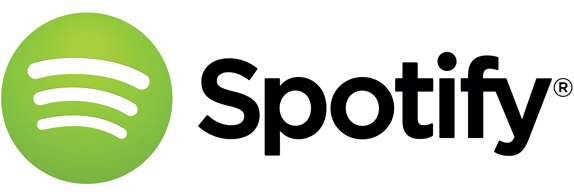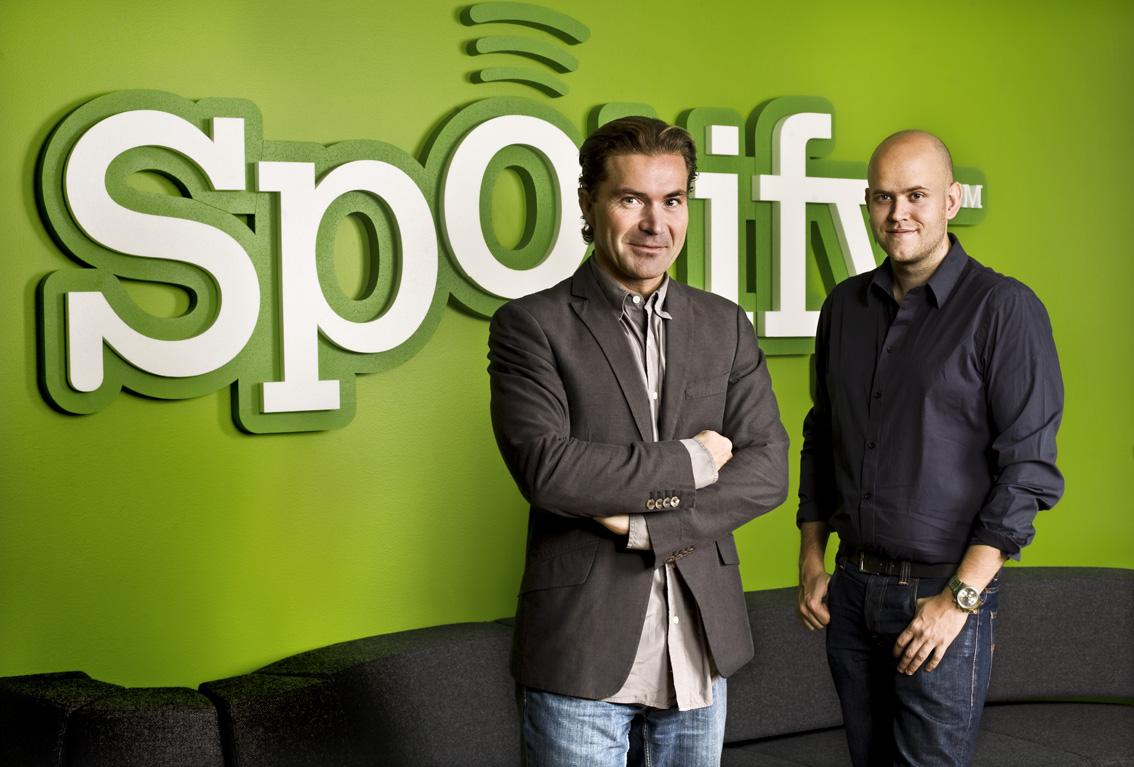
Company Overview:
Of the many streaming services in the world of music, the second largest behind the user-generated giant, Soundcloud, is a selective streaming service called Spotify. It was founded in Beta form in Europe in early 2007, and publically launched by October 2008 (Seabrook, 2014). Although its current company headquarters is in London, England, it was originally founded in Stockholm, Sweden, the home of its two founders Daniel Ek and Martin Lorentzon. Today, Spotify has offices in 18 countries, including two locations in Asia, sixteen in Europe, and their United States office located in Manhattan (spotify.com, 2016). Worldwide, the company has 1,370 employees, a relatively small number compared to the number of users and massive music catalogue. With close to 47,000,000 users at the end of 2015 and one of the most comprehensive streaming catalogues in existence, totalling 26,000,000 songs and counting, Spotify dwarfs its competitors (statisticbrain.com, 2015).
The company was founded by Daniel Ek, a young technologist and entrepreneur who was briefly the CEO of both uTorrent and BitTorrent, and also Martin Lorentzon, another tech entrepreneur who founded the Swedish marketing company TradeDoubler. Technically, the mastermind behind the whole project is Ek however, Spotify would not have flourished without the partnership. The pair began scheming a digital streaming platform in 2005, seeing, as the founder of Facebook puts it, “the opportunities of streaming music before anyone else” (Zuckerberg, as cited by Seabrook, 2014). Within a year post-launch, the pair had also designed both an Android and iOS application for the streaming platform, and by 2011, had accumulated 1,000,00 paid subscribers. Also in 2011, Spotify was finally made available in the United States, having availability exclusively in Europe for the first 3 years of its existence (Crook, Tepper, 2015). Today Spotify is available in fifty-eight countries worldwide (statisticbrain.com, 2015). Ek, the reining CEO of the company, currently sits at number twenty on the Billboard Power 100 list for 2015 (billboard.com, 2015).

Spotify founders, Martin Lorentzon (left), and Daniel Ek (right). Taken from http://thenextweb.com/eu/2011/07/14/spotify-the-story-so-far/
Assets:
All that Spotify technically has under its ownership umbrella is itself. Unlike some major media companies, Spotify does not have a major network of holdings. That being said, it does have a great system of partnerships with labels and publishers, insuring that all the artists represented in its extensive catalogue get paid fairly. Spotify also has a partnership with Facebook, established in 2011, and the two platforms continue to become more integrated (Cook, Tepper, 2015).
Something particularly interesting about Spotify’s music ownership system is that it doesn’t even own the rights to the songs that it puts out through its own series of “Spotify Sessions.” The record label of the individual artist still retains ownership of the master tracks recorded through these exclusive sessions, even though Spotify sponsors the recording process. This is interesting because generally the point of a label is to front the money for recording an album, and that gives it the exclusive rights to the master recordings.
Business Model:
Spotify is unique because it was the first of its kind in selective streaming. It houses a massive catalogue of millions of songs that users can arrange in playlists or play through at will. The Spotify staff compiles seemingly endless playlists spanning all genres and moods, and even personalized playlists updated every Monday for each user called “Discover Weekly.” Spotify also has a radio segment, much like Pandora, which lets you create a radio station based off an artist, song, or even playlist.

Screen Shot of Spotify’s “Browse” page, including an example of some of the available curated playlists.
The biggest controversy around the company, and why many artists like Taylor Swift decline association with it, is that it takes away the necessity for music ownership. While it is good that people are no longer downloading music illegally at such a high rate, digital downloads altogether have declined massively with the introduction of streaming (Tschmuck, 2014). Since Spotify’s launch, many other streaming services have begun popping up all over the place. The only companies whose business models compare to Spotify, however, are Tidal and Apple Music. Based on usership and catalogue, however, Spotify still entirely dominates the field. Still though, the world of digital downloads is thoroughly jeopardized by these services.
Revenue Model:
Spotify has two very different revenue models. There is a free tier, which includes advertisements every third or fourth song, and there is also an ad-free experience which costs $9.99 per month. This ad-free experience finances the company, and therefore its artists in a different way than the advertising tier does, but both bring in a lot of revenue for Spotify. Additionally, to sweeten the deal, Spotify also offers a student subscription service that offers the same Premium tier service at $4.99 per month for those who sign up with a student email account (spotify.com, 2016).
With the free version, users can not choose their music at will on the mobile application. The only option is to shuffle-play pre-existing playlists, albums, or artists. That is one major incentive for people switching to the Premium tier. With the paid version, a user essentially has all the music they want at his or her fingertips. Of the 47,000,000 users, about 12,000,000 of them are paid subscribers, meaning that Spotify is collecting massively every month (statisticbrain.com, 2015).
Interestingly enough though, Spotify makes very little payout to its artists. One single stream of one song is worth only $0.0084 from a paying user. A free tier user only makes an artist $0.003 per stream (statisticbrain.com, 2015). This means that one song must be streamed 125 times or more for an artist to make even a single dollar. For the big-name artists like Rihanna and Drake, who average 16,858,911 or 23,584,645 streams per month respectively, this still means a huge payout, but for smaller independent artists, streaming is not a viable source of income (spotify.com, 2016).
Looking to the Future:
Spotify has become one of the biggest players on the field, as the third largest streaming service available in terms of number of users. The only companies that dwarf Spotify are Soundcloud and Pandora, both of which have different streaming models and don’t pose much threat to what Spotify can provide for its customers. Because of this, there is so much potential in what Spotify can do moving forward. There is talk of a future in video content for Spotify, which would put it on a comparable plane to YouTube, another streaming giant that stands apart from the audio-only streaming services already discussed. Based on its three billion dollar valuation, it is safe to say that Spotify can kind of do whatever it wants at the moment (statisticbrain.com, 2015). It will be interesting to see how it continues to grow and evolve as it enters its second decade.
Sources:
About Us. (n.d.). Retrieved February 9, 2016, from spotify.com website: https://www.spotify.com/us/about-us/contact/
Crook, J., & Tepper, F. (2015, July 29). A Brief History of Spotify. Retrieved February 9, 2016, from techcrunch.com website: http://techcrunch.com/gallery/a-brief-history-of-spotify/
Daniel Ek: The 2015 Billboard Power 100. (2015, February 5). Retrieved February 9, 2016, from billboard.com website: http://www.billboard.com/biz/6465207/daniel-ek-the-2015-billboard-power-100
Greeley, B. (2011, July 14). Spotify’s Ek Wins Over Music Pirates With Labels’ Approval. Retrieved February 9, 2016, from bloomberg.com website: http://www.bloomberg.com/news/articles/2011-07-14/spotify-wins-over-music-pirates-with-labels-approval-correct-
Music for Everyone. (n.d.). Retrieved February 9, 2016, from spotify.com website:https://www.spotify.com/us/
Seabrook, J. (2014, November 24). Spotify: Friend or Foe? Retrieved February 9, 2016, from newyorker.com website: http://www.newyorker.com/magazine/2014/11/24/revenue-streams
Spotify Company Statistics. (2015, June 22). Retrieved February 9, 2016, from statisticbrain.com website: http://www.statisticbrain.com/spotify-company-statistics/
Student Discount. (n.d.). Retrieved February 9, 2016, from spotify.com website: https://www.spotify.com/us/student/
Tschmuck, P. (2014, March 21). The Recorded Music Market in the US: 2000-2013. Retrieved February 9, 2016, from musicbusinessresearch.wordpress.com website: https://musicbusinessresearch.wordpress.com/2014/03/21/the-recorded-music-market-in-the-us-2000-2013/
